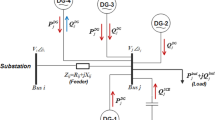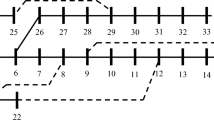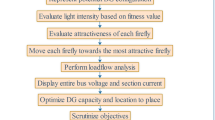Abstract
The power systems become operate closer to loadability limits; hence, the power systems static voltage stability assessment becomes an essential task in planning and operating for electric power systems to prevent voltage instability. In this paper, the improved moth flame optimization (IMFO) technique is applied for optimal location and size of (TCSC) with the aim of reducing load shedding, preventing voltage collapse, and enhancing the power system loadability. IMFO is developed to avoid the stagnating in local optima and improve the convergence characteristics of the conventional moth flame optimization. The loadability of the system is obtained using continuation power flow (CPF). The proposed approach is formulated by merging CPF with IMFO incorporated with TCSC. Multi-objective function is solved for minimization of loadability, load shedding, voltage stability index, and severity index. A contingency analysis is implemented on power system as two scenarios: The first scenario is outage of generator and the second scenario is outage line. Placement of TCSC has been determined by power flow analysis. The developed approach is tested on standard IEEE-30 bus system in normal operation, and contingency cases of generator and bus outage. The IMFO is compared to recent and well-known optimization techniques. The results reveal the efficiency of the proposed algorithm to reduce load shedding, continuous energy service to the customers and prevent occurrence of voltage collapse.





















Similar content being viewed by others
References
Larik RM, Mustafa MW, Otuoze AO, Mohammed OO, Sule AH (2018) A new technique of load shedding to stabilize voltage magnitude and fast voltage stability index by using hybrid optimization. ARPN J Eng Appl Sci 13(8):2734–2745
Van Cutsem T, Vournas C (2007) Voltage stability of electric power systems. Springer, Berlin
Kundur P, Balu NJ, Lauby MG (1994) Power system stability and control, vol 7. McGraw-Hill, New York
Kundur P, Paserba J, Ajjarapu V, Andersson G, Bose A, Canizares C et al (2004) Definition and classification of power system stability. IEEE Trans Power Syst 19:1387–1401
Moazzami M, Hooshmand R, Khodabakhshian A, Yazdanpanah M (2013) Blackout prevention in power system using flexible AC transmission system devices and combined corrective actions. Electr Power Compon Syst 41:1433–1455
Hooshmand R, Moazzami M (2012) Optimal design of adaptive under frequency load shedding using artificial neural networks in isolated power system. Int J Electr Power Energy Syst 42:220–228
Etingov P, Oudalov A, Voropai N, Germond A, Cherkaoui R (2005) Coordinated emergency control of load shedding and FACTS devices. IEEE Russia Power Tech 2005:1–8
Elango K, Paranjothi S (2010) Congestion management in restructured power systems by FACTS devices and load shedding using extended quadratic interior point method. Int J Appl Eng Res 1:767
Arya L, Koshti A (2014) Anticipatory load shedding for line overload alleviation using teaching learning based optimization (TLBO). Int J Electr Power Energy Syst 63:862–877
Le TN, Quyen HA, Nguyen NA (2016) Application of fuzzy-analytic hierarchy process algorithm and fuzzy load profile for load shedding in power systems. Int J Electr Power Energy Syst 77:178–184
Xu Y, Dong ZY, Luo F, Zhang R, Wong KP (2014) Parallel-differential evolution approach for optimal event-driven load shedding against voltage collapse in power systems. IET Gener Transm Distrib 8:651–660
Moors C (2002) On the design of load shedding schemes against voltage instability in electric power systems. PhD thesis, University of Liège, Fac. of Applied Sciences
Amraee T, Ranjbar A, Mozafari B, Sadati N (2007) An enhanced under-voltage load-shedding scheme to provide voltage stability. Electr Power Syst Res 77:1038–1046
Sarmiento H, Castellanos R, Pampin G, Villa G, Mirabal M (2008) Revisiting undervoltage load shedding schemes: a step by step approach. In: Transmission and distribution conference and exposition. T&D. IEEE/PES, pp 1–6
Kaffashan I, Amraee T (2015) Probabilistic undervoltage load shedding using point estimate method. IET Gener Transm Distrib 9:2234–2244
Laghari J, Mokhlis H, Bakar A, Mohamad H (2013) Application of computational intelligence techniques for load shedding in power systems: a review. Energy Convers Manag 75:130–140
Hong Y-Y, Chen P-H (2012) Genetic-based underfrequency load shedding in a stand-alone power system considering fuzzy loads. IEEE Trans Power Deliv 27:87–95
Lim Y, Kim H-M (2014) Strategic bidding using reinforcement learning for load shedding in microgrids. Comput Electr Eng 40:1439–1446
Amraee T, Mozafari B, Ranjbar A (2006) An improved model for optimal under voltage load shedding: particle swarm approach. In: Power India conference, 2006 IEEE. p 6
Chuvychin VN, Gurov N, Venkata S, Brown R (1996) An adaptive approach to load shedding and spinning reserve control during underfrequency conditions. IEEE Trans Power Syst 11:1805–1810
Mageshvaran R, Jayabarathi T, Prabha DR (2012) Optimal load shedding based on line voltage stability index using shuffled frog leaping algorithm and artificial bee colony algorithm. Int Rev Electr Eng Iree 7:6235–6244
Craciun D, Ichim S, Besanger Y (2009) A new soft load shedding: power system stability with contribution from consumers. In: PowerTech, 2009 IEEE Bucharest. pp 1–6
Wang G-G, Deb S, Cui Z (2019) Monarch butterfly optimization. Neural Comput Appl 31:1995–2014
Wang G-G, Deb S, dos Santos Coelho L (2018) Earthworm optimisation algorithm: a bio-inspired metaheuristic algorithm for global optimisation problems. IJBIC 12:1–22
Wang G-G, Deb S, Coelho LDS (2015) Elephant herding optimization. In: 2015 3rd International symposium on computational and business intelligence (ISCBI). pp 1–5
Roy AK, Jain SKG (2011) Contingency analysis in power system
Shaheen HI, Rashed GI, Cheng S (2011) Optimal location and parameter setting of UPFC for enhancing power system security based on differential evolution algorithm. Int J Electr Power Energy Syst 33:94–105
Taher SA, Amooshahi MK (2011) Optimal placement of UPFC in power systems using immune algorithm. Simul Model Pract Theory 19:1399–1412
Taher SA, Amooshahi MK (2012) New approach for optimal UPFC placement using hybrid immune algorithm in electric power systems. Int J Electr Power Energy Syst 43:899–909
Moazzami M, Morshed MJ, Fekih A (2016) A new optimal unified power flow controller placement and load shedding coordination approach using the hybrid imperialist competitive algorithm-pattern search method for voltage collapse prevention in power system. Int J Electr Power Energy Syst 79:263–274
Kolias C, Kambourakis G, Maragoudakis M (2011) Swarm intelligence in intrusion detection: a survey. COSE Comput Secur 30:625–642
Keerthi S, Ashwini K, Vijaykumar M (2015) Survey paper on swarm intelligence. Int J Comput Appl 115:1–5
Mavrovouniotis M, Li C, Yang S (2017) A survey of swarm intelligence for dynamic optimization: algorithms and applications. Swarm E Swarm Evol Comput 33:1–17
Rocha L, Castro R, de Jesus JF (2016) An improved particle swarm optimization algorithm for optimal placement and sizing of STATCOM. Int Trans Electr Energy Syst 26:825–840
Ajjarapu V, Christy C (1992) The continuation power flow: a tool for steady state voltage stability analysis. IEEE Trans Power Syst 7:416–423
Jiang P, Feng S, Wu X (2014) Robust design method for power oscillation damping controller of STATCOM based on residue and TLS-ESPRIT. Int Trans Electr Energy Syst 24:1385–1400
Ajjarapu V (2007) Computational techniques for voltage stability assessment and control. Springer, Berlin
Milano F, Cañizares CA, Conejo AJ (2005) Sensitivity-based security-constrained OPF market clearing model. IEEE Trans Power Syst 20:2051–2060
Gaur D, Mathew L (2018) Optimal placement of FACTS devices using optimization techniques: a review. In: 3rd International conference on communication systems, IOP conference series: materials science and engineering. pp 331
Kavitha K, Neela R (2017) Optimal allocation of multi-type FACTS devices and its effect in enhancing system security using BBO, WIPSO & PSO. J Electr Syst Inf Technol 5(3):777–793
Mandloi T, Jain AK (2014) A study of power system security and contingency analysis. Int J Sci Res Eng Technol (IJSRET). ISSN: 2278-0882
Mageshvaran R, Jayabarathi T (2015) GSO based optimization of steady state load shedding in power systems to mitigate blackout during generation contingencies. Ain Shams Eng J 6:145–160
Mageshvaran R, Jayabarathi T (2015) Steady state load shedding to mitigate blackout in power systems using an improved harmony search algorithm. Ain Shams Eng J 6:819–834
Modarresi J, Gholipour E, Khodabakhshian A (2016) A comprehensive review of the voltage stability indices. RSER Renew Sustain Energy Rev 63:1–12
Mirjalili S (2015) Moth-flame optimization algorithm: a novel nature-inspired heuristic paradigm. KNOSYS Knowl Based Syst 89:228–249
Bozorg-Haddad O (2018) Advanced optimization by nature-inspired algorithms
Soliman GM, Khorshid MM, Abou-El-Enien TH (2016) Modified moth-flame optimization algorithms for terrorism prediction. Int J Appl Innov Eng Manag 5:47–58
Taher MA, Kamel S, Kamel S, Jurado F, Ebeed M (2018) An improved moth-flame optimization algorithm for solving optimal power flow problem. Int Trans Elecr Energy Syst 29:e2743
Wang G-G (2018) Moth search algorithm: a bio-inspired metaheuristic algorithm for global optimization problems. Memet Comput 10:151–164
Mirjalili S, Lewis A (2016) The whale optimization algorithm. Adv Eng Softw 95:51–67
Nematollahi AF, Rahiminejad A, Vahidi B (2017) A novel physical based meta-heuristic optimization method known as lightning attachment procedure optimization. Appl Soft Comput 59:596–621
Mirjalili S (2016) SCA: a sine cosine algorithm for solving optimization problems. Knowl Based Syst 96:120–133
Acknowledgements
The authors would like to acknowledge the support of the Chilean Council of Scientific and Technological Research, ANID/Fondap/15110019.
Author information
Authors and Affiliations
Corresponding author
Additional information
Publisher's Note
Springer Nature remains neutral with regard to jurisdictional claims in published maps and institutional affiliations.
Rights and permissions
About this article
Cite this article
Sayed, F., Kamel, S., Taher, M.A. et al. Enhancing power system loadability and optimal load shedding based on TCSC allocation using improved moth flame optimization algorithm. Electr Eng 103, 205–225 (2021). https://doi.org/10.1007/s00202-020-01072-w
Received:
Accepted:
Published:
Issue Date:
DOI: https://doi.org/10.1007/s00202-020-01072-w




